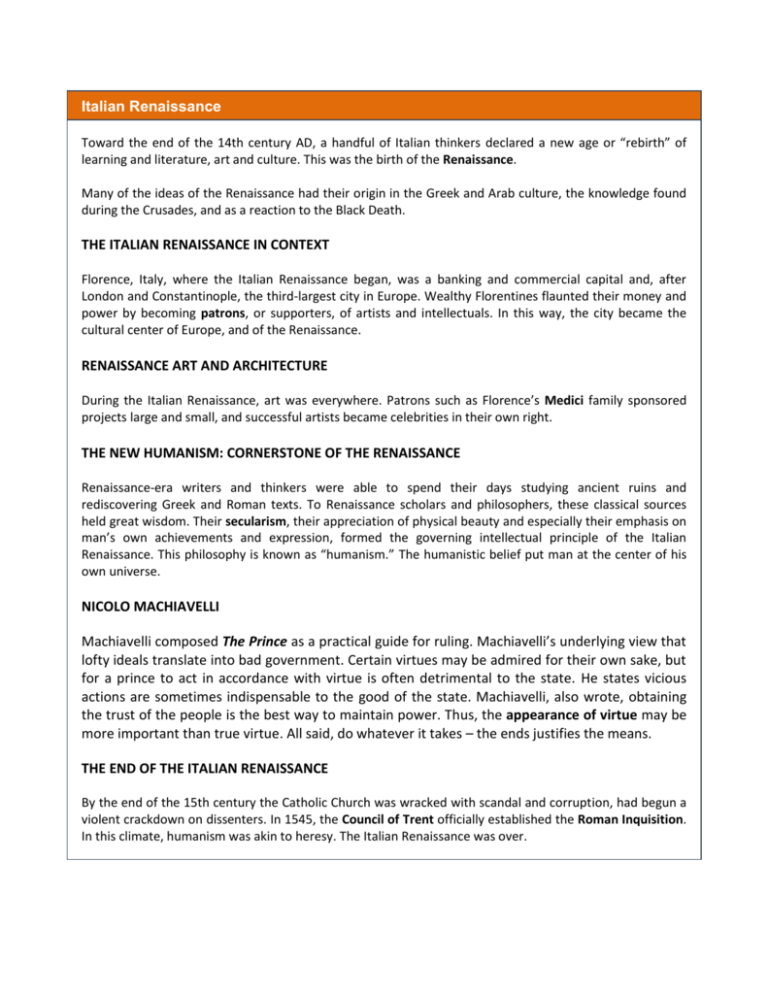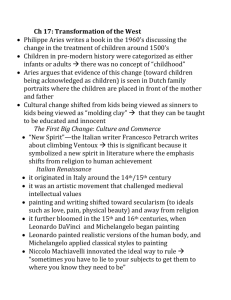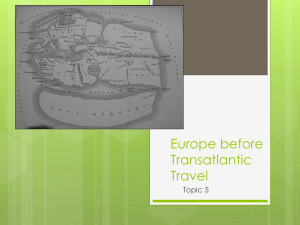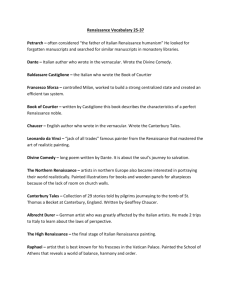7.01 Notes_Italian Renaissance
advertisement

Italian Renaissance Toward the end of the 14th century AD, a handful of Italian thinkers declared a new age or “rebirth” of learning and literature, art and culture. This was the birth of the Renaissance. Many of the ideas of the Renaissance had their origin in the Greek and Arab culture, the knowledge found during the Crusades, and as a reaction to the Black Death. THE ITALIAN RENAISSANCE IN CONTEXT Florence, Italy, where the Italian Renaissance began, was a banking and commercial capital and, after London and Constantinople, the third-largest city in Europe. Wealthy Florentines flaunted their money and power by becoming patrons, or supporters, of artists and intellectuals. In this way, the city became the cultural center of Europe, and of the Renaissance. RENAISSANCE ART AND ARCHITECTURE During the Italian Renaissance, art was everywhere. Patrons such as Florence’s Medici family sponsored projects large and small, and successful artists became celebrities in their own right. THE NEW HUMANISM: CORNERSTONE OF THE RENAISSANCE Renaissance-era writers and thinkers were able to spend their days studying ancient ruins and rediscovering Greek and Roman texts. To Renaissance scholars and philosophers, these classical sources held great wisdom. Their secularism, their appreciation of physical beauty and especially their emphasis on man’s own achievements and expression, formed the governing intellectual principle of the Italian Renaissance. This philosophy is known as “humanism.” The humanistic belief put man at the center of his own universe. NICOLO MACHIAVELLI Machiavelli composed The Prince as a practical guide for ruling. Machiavelli’s underlying view that lofty ideals translate into bad government. Certain virtues may be admired for their own sake, but for a prince to act in accordance with virtue is often detrimental to the state. He states vicious actions are sometimes indispensable to the good of the state. Machiavelli, also wrote, obtaining the trust of the people is the best way to maintain power. Thus, the appearance of virtue may be more important than true virtue. All said, do whatever it takes – the ends justifies the means. THE END OF THE ITALIAN RENAISSANCE By the end of the 15th century the Catholic Church was wracked with scandal and corruption, had begun a violent crackdown on dissenters. In 1545, the Council of Trent officially established the Roman Inquisition. In this climate, humanism was akin to heresy. The Italian Renaissance was over. Leonardo Di Vinci and Michelangelo LEONARDO DA VINCI: “THE LAST SUPPER” AND “MONA LISA” Leonardo da Vinci (1452-1519) was a painter, architect, inventor, and student of all things scientific. His natural genius crossed so many disciplines that he epitomized the term “Renaissance man.” Art, da Vinci believed, was indisputably connected with science and nature. He filled dozens of secret notebooks with inventions, observations and theories about pursuits from aeronautics to anatomy. His contemporaries often did not fully appreciate his genius—the combination of intellect and imagination that allowed him to create, at least on paper, such inventions as the bicycle, the helicopter, military tanks, and an airplane. Although relatively few of da Vinci’s paintings and sculptures survive, two of his works are among the world’s most well-known and admired paintings. “The Last Supper” depicts the Passover dinner during which Jesus Christ addresses the Apostles and says, “One of you shall betray me.” In Florence, he painted a series of portraits that included “La Gioconda,” a 21-by-31-inch work that’s best known today as “Mona Lisa.” The woman depicted—especially because of her mysterious slight smile— has been the subject of speculation for centuries. In the past she was often thought to be Mona Lisa Gherardini, a courtesan, but current scholarship indicates that she was Lisa del Giocondo, wife of Florentine merchant Francisco del Giocondo. Today, the portrait—the only da Vinci portrait from this period that survives—is housed at the Louvre Museum in Paris, France.. Michelangelo (1475-1564) was a sculptor, painter and architect widely considered to be one of the greatest artists of the Italian Renaissance period—and arguably of all time. His work demonstrated a blend of psychological insight, physical realism and intensity never before seen. His contemporaries recognized his extraordinary talent, and Michelangelo received commissions from some of the most wealthy and powerful men of his day, including popes and others affiliated with the Catholic Church. His resulting work, most notably his Pietà and David sculptures and Sistine Chapel ceiling paintings, has been carefully tended and preserved, ensuring that future generations would be able to view and appreciate Michelangelo’s genius. DAVID PIETA SISTINE CHAPEL MONA LISA LAST SUPPER







